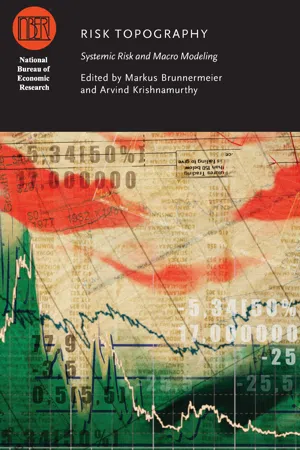![]()
II
Risk Exposures
![]()
3
Systemic Risk Exposures
A 10-by-10-by-10 Approach
Darrell Duffie
Here, I present and discuss a “10-by-10-by-10” network-based approach to monitoring systemic financial risk. Under this approach, a regulator would analyze the exposures of a core group of systemically important financial firms to a list of stressful scenarios, say ten in number. For each scenario, about ten such designated firms would report their gains or losses. Each reporting firm would also provide the identities of the ten, say, counterparties with whom the gain or loss for that scenario is the greatest in magnitude relative to all counterparties. The gains or losses with each of those ten counterparties would also be reported, scenario by scenario.
Gains and losses would be measured in terms of market value and also in terms of cash flow, allowing regulators to assess risk magnitudes in terms of stresses to both economic values and also liquidity. Exposures would be measured before and after collateralization. One of the scenarios would be the failure of a counterparty. The “top ten” counterparties for this scenario would therefore be those whose defaults cause the greatest losses to the reporting firm.
In eventual practice, the number of reporting firms, the number of stress scenarios, and the number of major counterparties could all exceed ten, but it is reasonable to start with a small reporting system until the approach is better understood and agreed upon internationally.
This systemic risk-monitoring system would be more effective if adopted by regulators in several major jurisdictions. Pooled reports that are based on coordinated choices of stress scenarios would reveal systemic risk more comprehensively.
With such a monitoring system in place, a regulator charged with supervision of the stability of the financial system would be in a position to quickly answer a range of questions concerning concentrations of stress on the central nodes and links of the system. Examples of the questions that could arise include the following:
1. Is it true that some large hedge funds have taken significant foreign-exchange positions with systemically important banks? Who are these hedge funds? Do any of them also pose potentially large counterparty default exposures to any of these banks? How large are the associated market-value and cash-flow impacts?
2. If treasury yields were to rise dramatically, how much would systemically important financial institutions gain or lose in total, from each other and from others?
3. How prominent are central clearing counterparties (CCPs) among the top counterparties to systemically important firms?
4. What sorts of major financial firms have short positions with respect to real estate markets, and with whom do they hold their largest positions in this asset class?
5. Do the exposure results obtained from the reporting firms allow us to identify any previously undetected systemically important firms?
Although 10-by-10-by-10 reports would be collected from a small number of designated firms, the results would likely shed light on risk flows between these firms and potentially many other firms. Because of this, a regulator may be able to identify nonreporting firms that are candidates to be designated as systemically important, and perhaps also be added to the list of reporting firms. This process of augmenting the reported network can be iterated. An analysis of 10-by-10-by-10 data could also trigger follow-up supervisory conversations between regulators and individual firms, or groups of firms. For example, a regulator might wish to alert a group of banks that they have significant exposures in the same asset class and in the same direction with a concentrated common set of counterparties.
It is to be emphasized that this approach to systemic risk monitoring is much broader than a counterparty default exposure measurement system, although counterparty default exposures are included in it. For a given scenario, large gains shed as much light on risk flows through the financial system as do large losses. Moreover, even if reported gains and losses do not threaten the viability of reporting firms or their immediate counterparties, they may be important clues to the magnitudes of risk flows in given asset classes, and may allow regulators to consider the potential for contagion through fire sales.
Under this monitoring scheme, once revised and implemented, the reporting entities would provide the stipulated measures periodically, say quarterly, to designated regulators. Regulators from various jurisdictions would pool and then analyze the data. The overall objective would be to monitor the exposure of the financial system to systemically important stresses. The joint exposure of the system to the performance of particular asset classes, macroeconomic events, and entities (or chains of entities) could, as a result, be clarified. Summary information could be publicly disclosed, for example, in the form of histograms or population statistics, making a reasonable trade-off of the costs and benefits of releasing firm-specific or detailed data. For example, the Financial Services Authority of the United Kingdom has provided semiannual reports of the default exposures of UK banks to hedge fund counterparties. Public knowledge of summary information regarding stresses across the financial system of various types may contribute to an endogenous lowering of critical stresses through repricing and portfolio adjustments.
Regulators may choose to be cautious, however, about creating additional uncertainty, or potentially even triggering runs, through public reporting of detailed firm-specific contemporaneous stress information.1 Rather, their objective may be to alert themselves and the public to potential sources of financial instability before they reach dangerous levels.
Full and immediate public disclosure of firm-specific stress reports could also dampen the incentives of reporting firms to act as liquidity providers, temporarily warehousing risk, as modeled by Grossman and Miller (1988) and Brunnermeier and Pedersen (2009). Intermediaries would expect more severe price impacts when unloading large positions if the sizes of their positions are known publicly. Bid-offer spreads would widen, and market liquidity could suffer as a result. For similar reasons, in the face of instant public disclosure of their positions, the incentives to gather fundamental information would be reduced, worsening the price-discovery function of financial markets.
Separate analysis would likely sugges...
